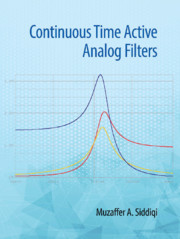Book contents
- Frontmatter
- Dedication
- Contents
- Preface
- Acknowledgments
- 1 Analog Filter: Concepts
- 2 First-and Second-order Filters
- 3 Magnitude Approximations
- 4 Delay: Approximation and Optimization
- 5 Frequency and Impedance Transformations
- 6 Sensitivity of Active Networks
- 7 Single Amplifier Second-order Filters
- 8 Multi Amplifier Second-order Filter Sections
- 9 Direct Form Synthesis: Element Substitution and Operational Simulation
- 10 Cascade Approach: Optimization and Tuning
- 11 Amplification and Filtering in Biomedical Applications
- 12 Audio Signal Processing and Anti-aliasing Filters
- 13 Follow the Leader Feedback Filters
- 14 Switched Capacitor Circuits
- 15 Operational Transconductance Amplifier-C Filters
- 16 Current Conveyors and CDTA (Current Differencing Transconductance Amplifiers) Based Filters
- 17 Active R and Active C Filters
- Index
13 - Follow the Leader Feedback Filters
Published online by Cambridge University Press: 24 December 2019
- Frontmatter
- Dedication
- Contents
- Preface
- Acknowledgments
- 1 Analog Filter: Concepts
- 2 First-and Second-order Filters
- 3 Magnitude Approximations
- 4 Delay: Approximation and Optimization
- 5 Frequency and Impedance Transformations
- 6 Sensitivity of Active Networks
- 7 Single Amplifier Second-order Filters
- 8 Multi Amplifier Second-order Filter Sections
- 9 Direct Form Synthesis: Element Substitution and Operational Simulation
- 10 Cascade Approach: Optimization and Tuning
- 11 Amplification and Filtering in Biomedical Applications
- 12 Audio Signal Processing and Anti-aliasing Filters
- 13 Follow the Leader Feedback Filters
- 14 Switched Capacitor Circuits
- 15 Operational Transconductance Amplifier-C Filters
- 16 Current Conveyors and CDTA (Current Differencing Transconductance Amplifiers) Based Filters
- 17 Active R and Active C Filters
- Index
Summary
Introduction
One of the important issues in filter design is that parameter sensitivity has to be taken into consideration. A doubly terminated ladder is extensively used mainly because of the same reason, that is, parameters of the filter realized through it have low sensitivities. At the same time, an alternate synthesis method using the cascade approach has found favour because of its ability to tune specific pole–zeros in higher-order filters through the utilization of noninteractive second-order sections. However, in the cascade process, sensitivities increase, especially for high-Q filters. Since we know that negative feedback improves the performance of electronic circuits in a number of ways, the same have been applied to obtain what is known as multiple feedback (MF) topologies. An MF topology consists of a network with a single feed-forward path comprising unilateral (active structures are mostly unilateral unlike passive structures which are bilateral) second-order sections, having different kind of feedbacks. The nature of the feedback decides its final topology. One of the topologies is called leap frog and was discussed in Chapter 9. While performing operational simulation, the circuit had a topology shown in Figures 9.22 and 9.24, where it is easy to recognize the structure as a leap frog structure. Another topology under the broad area of MF topologies known as follow the leader feedback (FLF) is the subject of this chapter.
In Section 13.2, the basic FLF structure and the kind of transfer functions obtained is included. Also included in this section is the derivation of the structure's transfer function when either lossless integrators or lossy integrators are used in the feedback paths. Use of only a feedback block could provide all pole functions. Hence, feed-forward is also included, as will be discussed in Section 13.3, to improve the versatility of the scheme. A slightly modified feed-forward scheme, called the shifted companion structure is discussed in Section 13.4. It was observed that all these schemes were special cases of a general FLF structure that is given in Section 13.5. Without sacrificing the generality, synthesis of the filter becomes a bit easier if the feedback blocks have BP structures with equal value of quality factor, instead of different quality factors. Such a scheme, known as the primary resonator block technique is also discussed in this chapter.
Information
- Type
- Chapter
- Information
- Continuous Time Active Analog Filters , pp. 398 - 423Publisher: Cambridge University PressPrint publication year: 2020
